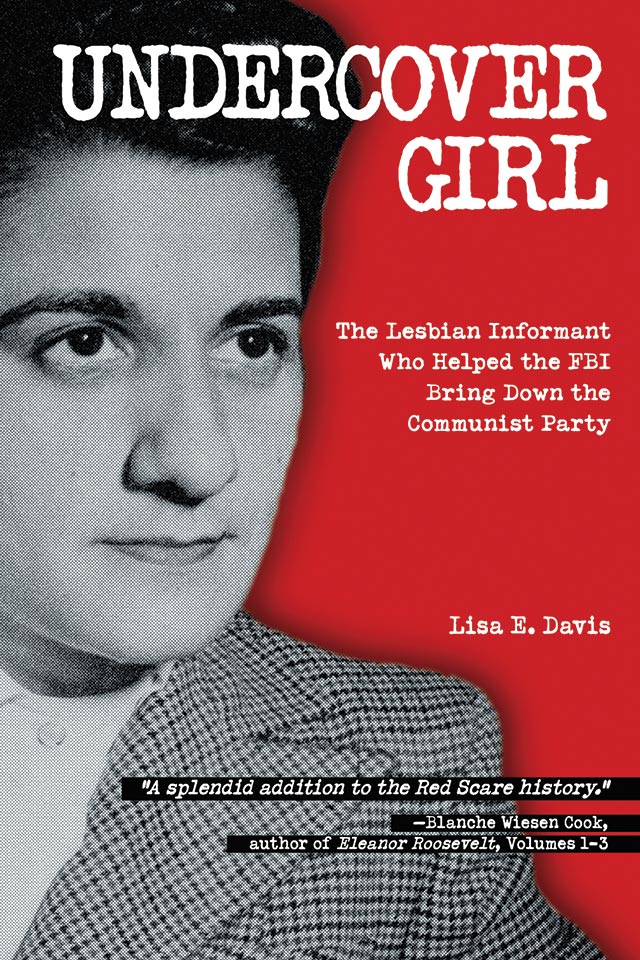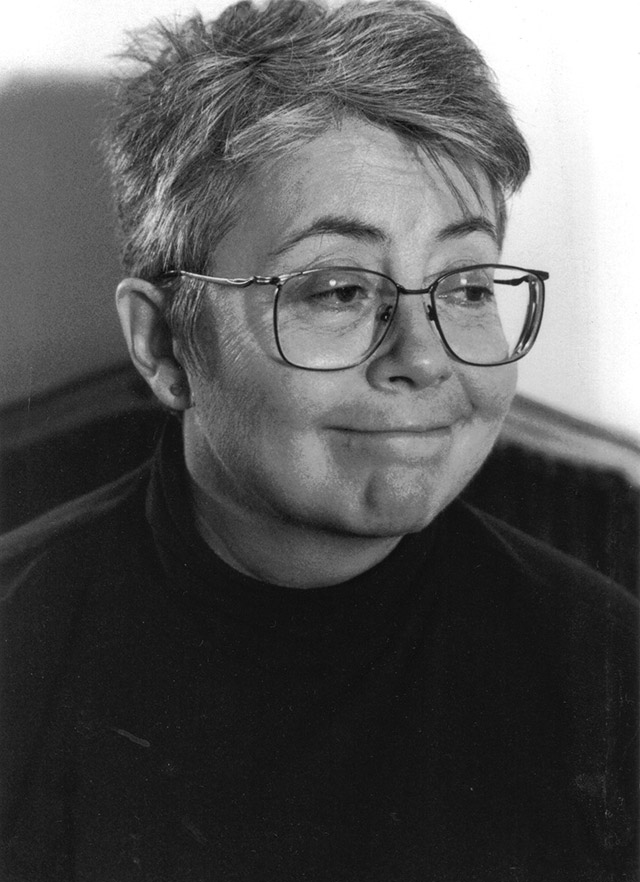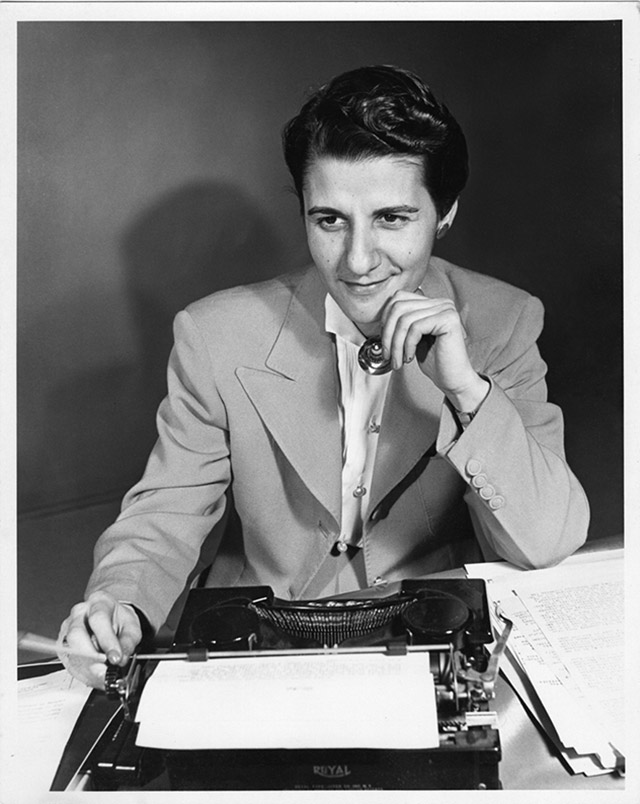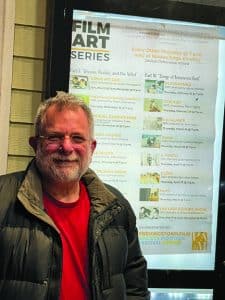by Jeannette de Beauvoir
These days, it’s called Angel’s Landing and is advertised as “a delightful place to hang your halo.” But the efficiency condominiums on Commercial Street in Provincetown were purchased and developed in the 1960s by Angela Calomiris, a woman escaping the publicity of having worked undercover for the then-nascent Federal Bureau of Investigation, betraying and ultimately destroying not only New York’s leftist Photo League but also ultimately the CPUSA—the American Communist Party.

Davis first got interested in Angela Calomiris on another project. “I was working on the Hollywood HUAC [House Un-American Activities Committee] hearings,” she says, “and heard an interview that Joan Nestle had done with an old gay girl from the Village where the 1950s Red Scare came up. Angie turned out to be one of the culprits.”
The word “culprits” isn’t chosen at random. Calomiris damaged lives and careers, as did the McCarthy era she helped usher in. She began her own calling as part of the Photo League, where she didn’t play the starring role she’d imagined for herself and so turned elsewhere for excitement. “I think she would have liked to be an artist, a Margaret Bourke-White,” says Davis. “But that would have been so much harder, probably impossible for a little butch dyke. And maybe she just didn’t have the talent or the sticking power.”
The Photo League began life as the Workers Film and Photo League. Sid Grossman, Calomiris’ mentor (whom, among others, she breezily sold out) was the cooperative’s founder and unabashedly Communist, though the League officially broke with the party in 1936. It attracted the cream of the mid-century photographer crop: Paul Strand, Berenice Abbott, Margaret Bourke-White, W. Eugene Smith, Helen Levitt, Arthur Rothstein, Richard Avedon, Weegee, Ansel Adams. Calomiris, with apparently no evidence, asserted to the FBI that the Photo League was a front to move people into the American Communist Party.

She pushed the right buttons. In her memoir, grandly titled Red Masquerade, Calomiris admits that the FBI was looking for people “who have had a hard row to hoe and look as if they could be persuaded to stop trying.” She apparently fit the bill, and took to spying with gusto. While she seems to have started with some socialist beliefs, her new role gave her the opportunity to do something about her own sour grapes. “A surprising number of them,” she writes, “were in the Party because they could find no other social life.”
Social life was an issue. Homosexuality was illegal, and so she had to have been adept at the secret world in which it moved; it’s possible that the FBI saw that as an asset. How much did her lesbianism play into Calomiris’ activities? “I don’t think she was blackmailed or coerced,” says Davis. “She just wanted the money and the promised jobs—which didn’t materialize—and she gained tremendous prestige for a while for her actions.” That prestige included radio appearances with Eleanor Roosevelt and the publication of a singularly self-congratulatory memoir.
She was responsible for closing down the League and for the ruin of many artistic careers. Photographers who for years had documented life in New York’s streets, who addressed social problems through the lens of their cameras, were ruined. At no point did she seem to care. Finally, in 1949, she was a star witness in the first Smith Act trial, the longest in U.S. history, which unleashed a media frenzy and led to decades of government targeting of “subversive” groups.
Calomiris complained bitterly of the pay she received (once she was forced to admit that she’d lied under oath about working for free) and grasped at what fame—and money—she could. She consistently made good business deals with the money she got from the FBI, and that was what led her eventually to Provincetown. “Her ability to make money, wheel and deal, is reflected in the many properties she owned in Ptown,” says Davis.
Calomiris apparently saw no irony in settling down in what had once been known as “Greenwich by the Sea,” the summer arts colony founded by the spiritual forebears of the very people she’d betrayed.
Provincetown had a history of leaning left ever since writers and artists made it their summer home early in the last century. In The Women of Provincetown, Cheryl Black says, “The Russian Revolution of 1917 took journalists Reed, Bryant, and Vorse overseas. Vorse became a propagandist for peace and Reed and Bryant for Communism.” Socialists, anarchists, and freethinkers made the town their own for a couple of decades, and in fact by 1935 the St. Louis Post-Dispatch ran a story on landscape artist and muralist Joe Jones titled “Provincetown Makes Artist a Communist,” while Time magazine noted that his new political sympathies were showing up in his art. That background may not have been apparent in the Provincetown of the 1960s, but it’s still an interesting choice of retirement venue for someone who betrayed the Left “for the money,” affirms Davis. “She did it for the money, and to get ahead in the business world. The Red Scare was a business.”

The question remains—whom did Angela Calomiris betray? Was it the American Communist Party that she infiltrated on behalf of the FBI? The American Left? Or her own artistic bohemian sensibilities?
“Angie isn’t the important issue here,” says Davis. “The important thing is the official annihilation of the American Left of the 1930s-40s by an establishment that had determined there would be no socialism in America, and that FDR’s New Deal had been a big mistake. We live with that decision every day as we sink deeper into the mire. I hope Bernie Sanders was not our last hope.”
Lisa E. Davis will be reading from Undercover Girl at the Provincetown Public Library, 356 Commercial St., on Saturday, May 20 at 3 p.m. For more information, call 508.487.7094 or visit provincetownlibrary.org.










